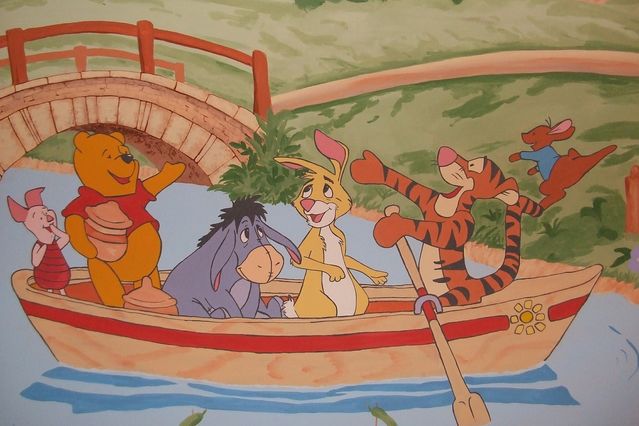Trauma
What Winnie the Pooh Can Teach Us About PTSD
Were our beloved characters A. A. Milne’s way of healing from trauma?
Posted August 12, 2019 Reviewed by Devon Frye

I have long considered Winnie the Pooh to be one of my favorite philosophers. However, as a clinician deeply steeped in the field of trauma recovery, I have begun to think that his creator A. A. Milne may also be one of my favorite psychologists. Naturally, it takes talent to write a children’s book filled with lovable and quirky characters, who teach children the true values of friendship, tolerance, unconditional acceptance, and playfulness. But it is something else entirely to be able to imbue these characters with personality traits that we intuitively feel drawn to, perhaps without fully understanding why.
The animals of the Hundred Acre Wood imperceptibly introduce children to the intricacies of the adult world. But I bet you did not realize that each beloved character could also be interpreted as illustrating certain symptoms of post-traumatic stress. Their most exaggerated personality characteristics can actually be seen as common responses to trauma and, even though we are not kids anymore, they can teach us a lot.
Here, in Part One of this article, I share why I believe that our beloved animal friends may be A. A. Milne’s way of sharing his pain, healing, and perhaps even connecting with his son. Trauma is complex and Milne's genius is in helping us not lose sight of the forest while staring at individual trees. In Part Two, we will play with each beloved animal from the Hundred Acre Wood and learn what each represents. Some of you may see yourselves in them, and some may see a loved one. In either case, I hope that through their cuteness, I can help you gain more insight into how traumatic events affect us without (or with) our awareness.
Why PTSD?
There have long been speculations that each animal in Milne’s books represents a different psychological disorder. Almost 20 years ago, an article appeared in the Canadian Medical Association Journal that argues exactly this. It declared Pooh to be suffering from ADHD, inattentive type, and possibly OCD. Piglet was diagnosed with Generalized Anxiety Disorder, while Eeyore was seen as dysthymic (a type of depressive disorder). Tigger, naturally, was a representation of ADHD, hyperactive/impulsive subtype and Rabbit was declared to suffer from Narcissistic Personality Disorder. There have also been rebuttals, which the curious reader can look up online.
This embarrassment of diagnostical riches when it comes to our beloved childhood friends is natural. Twenty years ago, clinicians had much less understanding of the impact of trauma. The diagnosis of PTSD itself continues to be revised with each iteration of the Diagnostic and Statistical Manual of mental disorders (DSM), and we are only now beginning to grasp the wide range of impact that trauma has on our functioning.
Looking at each character separately and giving them a diagnosis based on a sample of behaviors also illustrates a challenge for clinicians, as well as those experiencing the impact of trauma, today. I frequently see PTSD or complex trauma (mis)diagnosed as Major Depressive Disorder, Generalized Anxiety Disorder, Borderline Personality Disorder, or even on occasion Bipolar Disorder.
Developmental trauma (not yet an official diagnosis), on the other hand, frequently results in problems like addiction or eating disorders in adulthood (but not necessarily straightforward PTSD). The problem is that trauma responses and PTSD may encompass signs and symptoms from all of these mental health problems, and only noting the one that is most prominent jeopardizes proper diagnosis and treatment. It is only through looking at the full forest that we can accurately appreciate how it is more than a sum of its characters.
In addition, let us not forget that A. A. Milne himself was a war veteran. Even a cursory glance at his biography reveals that he was part of both World Wars, serving in combat at one of the bloodiest battles of WWI (Battle of Somme). He is known to have never been the same after his return and it is not a stretch to speculate that he himself was intimately familiar with the impact of trauma and PTSD. Some accounts of his life report that he had a difficult time adjusting to being a parent to his son, Christopher Robin (also not uncommon when one is struggling to recover from trauma). It is highly probable that using his children’s stories, Milne was attempting to heal and connect with his child through the only means available to him—the creative expression of his own experience.
Why Is This Important?
Living with PTSD, or with someone who is contending with PTSD, is not always easy. The aftermath of trauma does not happen in a vacuum and reverberates through the fabric of families and the community as a whole. Winnie and friends normalize some of that impact. They are cute and fluffy, kind and caring, and each has its own quirks. They remind us that irritability does not mean a lack of kindness, and that fear and anxiety may be “inconvenient” sometimes, but they are something that we experience, not something that defines our essence.
A. A. Milne likely found a creative way of talking about his struggles and those of many other individuals affected by trauma. He did this in a way that elicits compassion, a sense of community, and even laughter. Unconsciously, trauma overwhelms us and we may want to “shut down” or turn the other way, in order to not look at it. But when we do not look at it, it remains unprocessed within us, often impacting our feelings, behaviors, and relationships without us realizing it. We may also find ourselves unable to offer support to loved ones who are dealing with their own emotional burden. In breaking down the full picture of PTSD into smaller, more easily digestible characters, Milne allows us to see them as coexisting with all the other positive characteristics in our personalities, that may sometimes get lost or unnoticed when we are struggling.
In Part Two, I will review our beloved cast of characters and explain how each represents characteristics consistent with a trauma response. Not everyone who contends with PTSD will have all symptoms. You may see yourself more in Piglet and less in Owl, or more in Eeyore. Or you may be a different character every day, depending on the circumstances and stressors of your environment.
Head over to Part Two, in which the animals of the Hundred Acre Wood await!





